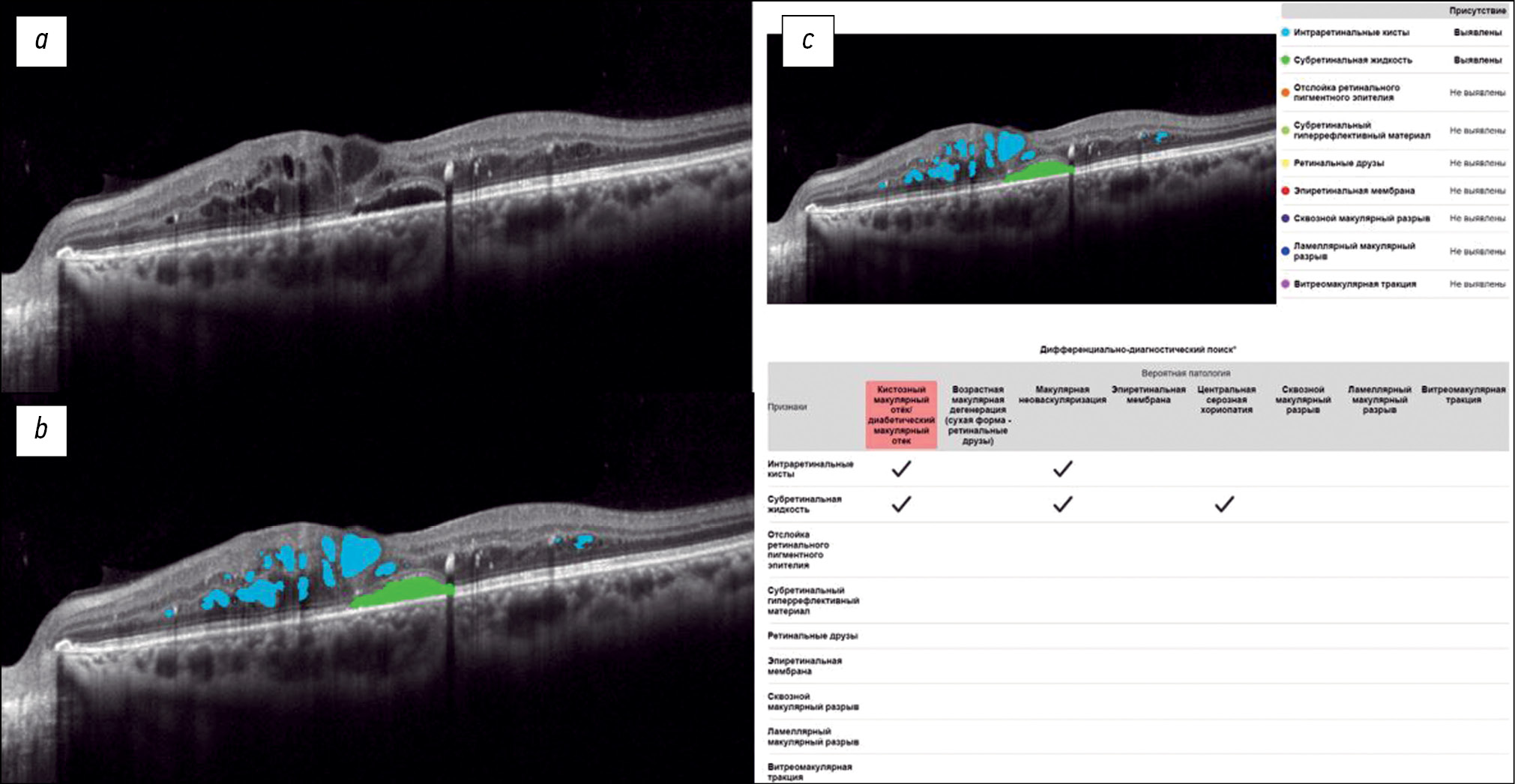Exploring the possibilities of an artificial intelligence program in the diagnosis of macular diseases
- Авторлар: Khabazova M.R.1, Ponomareva E.N.1, Loskutov I.A.2, Katalevskaya E.А.3, Sizov A.Y.3,4, Gabaraev G.М.1
-
Мекемелер:
- Federal Research and Clinical Center of Specialized Medical Care and Medical Technologies
- Moscow Regional Research and Clinical Institute
- Digital Vision Solutions LLC
- Nizhny Novgorod State Technical University n.a. R.E. Alekseev
- Шығарылым: Том 5, № 1 (2024)
- Беттер: 17-28
- Бөлім: Original Study Articles
- URL: https://journals.rcsi.science/DD/article/view/262945
- DOI: https://doi.org/10.17816/DD624131
- ID: 262945
Дәйексөз келтіру
Аннотация
BACKGROUND: Macular diseases are a large group of pathological conditions that cause vision loss and visual impairment. Early diagnosis of such changes plays an important role in treatment selection and is one of the crucial factors in predicting outcomes.
AIM: To examine the potential of an artificial intelligence program in the diagnosis of macular diseases using structural optical coherence tomography scans.
MATERIALS AND METHODS: The study included patients examined and treated at the Federal Research and Clinical Center of Specialized Medical Care and Medical Technologies and Moscow Regional Research and Clinical Institute. In total, 200 eyes with macular diseases were examined, as well as eyes without macular pathologies. A comparative clinical analysis of structural optical coherence tomography scans obtained using an RTVue XR 110-2 tomograph was conducted. The Retina.AI software was used to analyze optical coherence tomography scans.
RESULTS: In the analysis of optical coherence tomography scans using Retina.AI, various pathological structures of the macula were identified, and a probable pathology was then determined. The results were compared with the diagnoses made by ophthalmologists. The sensitivity, specificity, and accuracy of the method were 95.16%, 97.76%, and 97.38%, respectively.
CONCLUSION: Retina.AI allows ophthalmologists to automatically analyze optical coherence tomography scans and identify various pathological conditions of the fundus.
Толық мәтін
##article.viewOnOriginalSite##Авторлар туралы
Margarita Khabazova
Federal Research and Clinical Center of Specialized Medical Care and Medical Technologies
Email: rita.khabazova@mail.ru
ORCID iD: 0000-0002-7770-575X
SPIN-код: 2736-9089
Ресей, Moscow
Elena Ponomareva
Federal Research and Clinical Center of Specialized Medical Care and Medical Technologies
Email: ponomareva.en@fnkc-fmba.ru
ORCID iD: 0009-0001-0828-9844
SPIN-код: 7868-4425
Ресей, Moscow
Igor Loskutov
Moscow Regional Research and Clinical Institute
Email: loskoutigor@mail.ru
ORCID iD: 0000-0003-0057-3338
SPIN-код: 5845-6058
MD, Dr. Sci. (Medicine)
Ресей, MoscowEvgenia Katalevskaya
Digital Vision Solutions LLC
Email: ekatalevskaya@mail.ru
ORCID iD: 0000-0002-5710-9205
SPIN-код: 7849-8890
MD, Cand. Sci. (Medicine)
Ресей, MoscowAlexander Sizov
Digital Vision Solutions LLC; Nizhny Novgorod State Technical University n.a. R.E. Alekseev
Email: sizov_ost_vk@mail.ru
ORCID iD: 0000-0003-3338-4015
SPIN-код: 4468-1730
Ресей, Moscow; Nizhny Novgorod
Georgiy Gabaraev
Federal Research and Clinical Center of Specialized Medical Care and Medical Technologies
Хат алмасуға жауапты Автор.
Email: geor_gabaraev1@mail.ru
ORCID iD: 0000-0002-0759-3107
SPIN-код: 1802-3224
Ресей, Moscow
Әдебиет тізімі
- Report of the 2030 targets on effective coverage of eye care [Internet]. Geneva: World Health Organization. c2024. [cited 2023 Jan 1]. Available from: https://www.who.int/publications/i/item/9789240058002
- GBD 2019 Blindness and Vision Impairment Collaborators. Causes of blindness and vision impairment in 2020 and trends over 30 years, and prevalence of avoidable blindness in relation to VISION 2020: the Right to Sight: an analysis for the Global Burden of Disease Study. Lancet Glob Health. 2021;9(2):144–160. doi: 10.1016/S2214-109X(20)30489-7
- Samanta A, Aziz AA, Jhingan M, et al. Emerging Therapies in Neovascular Age-Related Macular Degeneration in 2020. Asia Pac J Ophthalmol (Phila). 2020;9(3):250–259. doi: 10.1097/APO.0000000000000291
- Stahl A. The Diagnosis and Treatment of Age-Related Macular Degeneration. Dtsch Arztebl Int. 2020;117:513–520. doi: 10.3238/arztebl.2020.0513
- Teo ZL, Tham YC, Yu M, et al. Global Prevalence of Diabetic Retinopathy and Projection of Burden through 2045: Systematic Review and Meta-analysis. Ophthalmology. 2021;128(11):1580–1591. doi: 10.1016/j.ophtha.2021.04.027
- Schaal S, Kaplan HJ, editors. Cystoid Macular Edema. Switzerland: Springer International Publishing; 2017. doi: 10.1007/978-3-319-39766-5
- Bikbov MM, Fayzrakhmanov RR, Zaynullin RM, et al. Macular oedema as manifestation of diabetic retinopathy. Diabetes mellitus. 2017;20(4):263–269. EDN: ZMZAON doi: 10.14341/DM8328
- Chernykh DV, Chernykh VV, Trunov AN. Cytokines and growth factors in the pathogenesis of proliferative diabetic retinopathy. Moscow: Oftal’mologiya; 2017. EDN: ZNDEWH
- Gupta A, Tripathy K. Central Serous Chorioretinopathy [Internet]. [Updated 2022 Aug 22]. In: StatPearls [Internet]. Treasure Island (FL): StatPearls Publishing, 2022. Available from: https://www.statpearls.com/point-of-care/96027
- Semeraro F, Morescalchi F, Russo A, et al. Central Serous Chorioretinopathy: Pathogenesis and Management. Clinical ophthalmology. 2019;13:2341–2352. doi: 10.2147/OPTH.S220845
- Oh KT, Lazzaro DR, editors. Macular Hole. [Internet]. Medscape, 2020. [cited 2020 Jan 02]. Available from: https://emedicine.medscape.com/article/1224320-overview#a6
- Darian-Smith E, Howie AR, Allen PL, et al. Tasmanian macular hole study: whole population-based incidence of full thickness macular hole. Clinical & Experimental Ophthalmology. 2016;44(9):812–816. doi: 10.1111/ceo.12801
- Fung AT, Galvin J, Tran T. Epiretinal membrane: A review. Clinical & Experimental Ophthalmology. 2021;49:289–308. doi: 10.1111/ceo.13914
- Oh KT, Lazzaro DR, editors. Epiretinal Membrane [Internet]. Medscape, 2020. [cited 2020 Jan 02]. Available from: https://emedicine.medscape.com/article/1223882-overview#a4
- World Health Organization. Regional Office for Europe. Screening for diabetic retinopathy: a short guide. Increase effectiveness, maximize benefits and minimize harm [Internet]. Copenhagen; 2021. [cited 2020 Jan 02]. Available from: https://www.who.int/europe/publications/i/item/9789289055321
- Qassimi AN, Kozak I, Karam AM, et al. Management of Diabetic Macular Edema: Guidelines from the Emirates Society of Ophthalmology. Ophthalmology and therapy. 2022;11:1937–1950. doi: 10.1007/s40123-022-00547-2
- Katalevskaya EA, Katalevskiy DYu, Tyurikov MI, Velieva IA, Bol’shunov AV. Future of artificial intelligence for the diagnosis and treatment of retinal diseases. Russian journal of clinical ophthalmology. 2022;22(1):36–43. EDN: AEBQGU doi: 10.32364/2311-7729-2022-22-1-36-43
- Schmidt-Erfurth U, Reiter GS, Riedl S, et al. AI-based monitoring of retinal fluid in disease activity and under therapy. Prog Retin Eye Res. 2022;86. doi: 10.1016/j.preteyeres.2021.100972
- Altris.ai [Internet]. United States: Altris Inc. [cited 2022 Jan 01]. Available from: https://www.altris.ai
- Malyugin BE, Sakhnov SN, Axenova LE, et al. A deep machine learning model development for the biomarkers of the anatomical and functional anti-VEGF therapy outcome detection on retinal OCT images. Fyodorov Journal of Ophthalmic Surgery. 2022;(S4):77–84. EDN: OWQLRM doi: 10.25276/0235-4160-2022-4S-77-84
Қосымша файлдар












